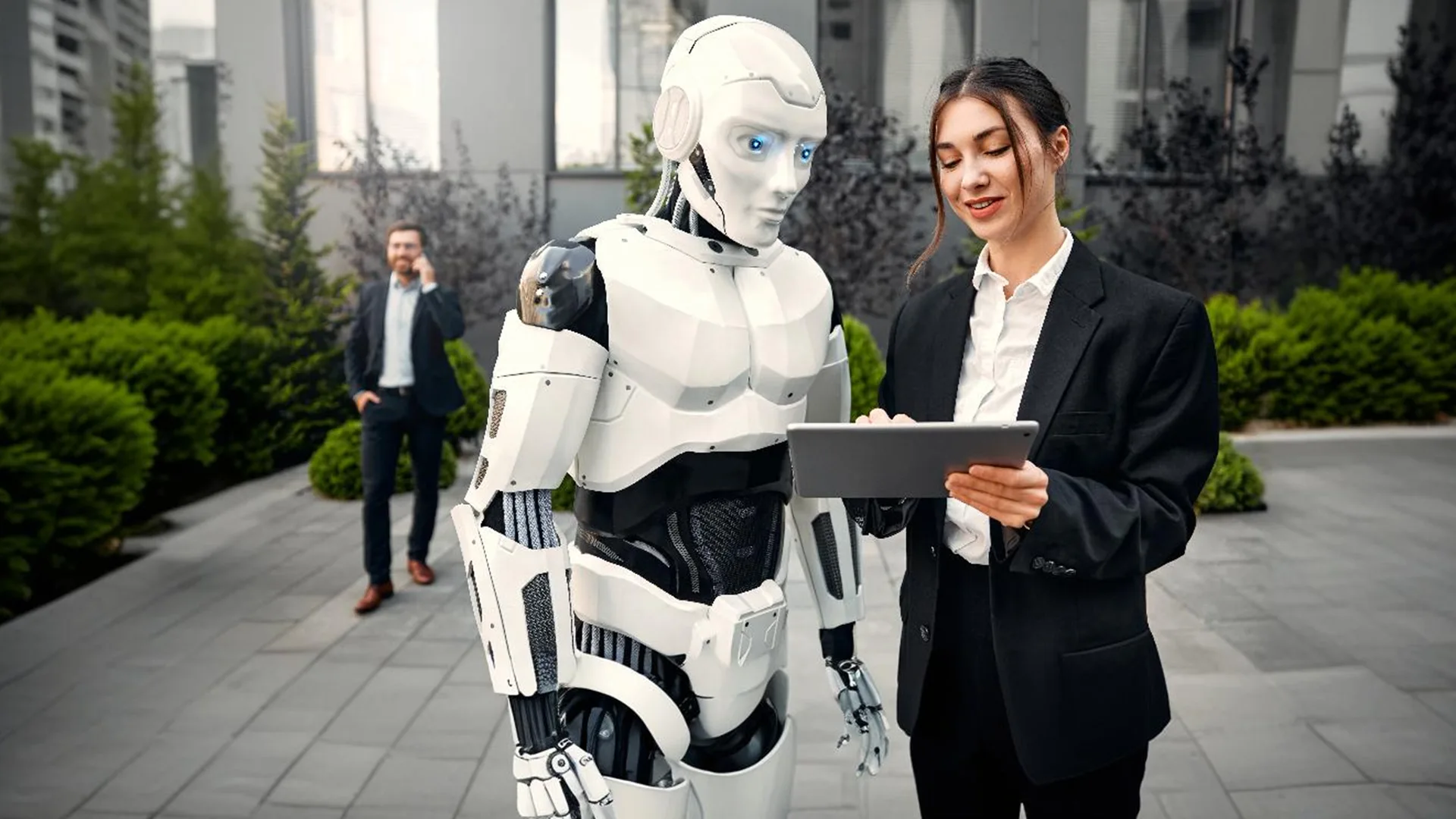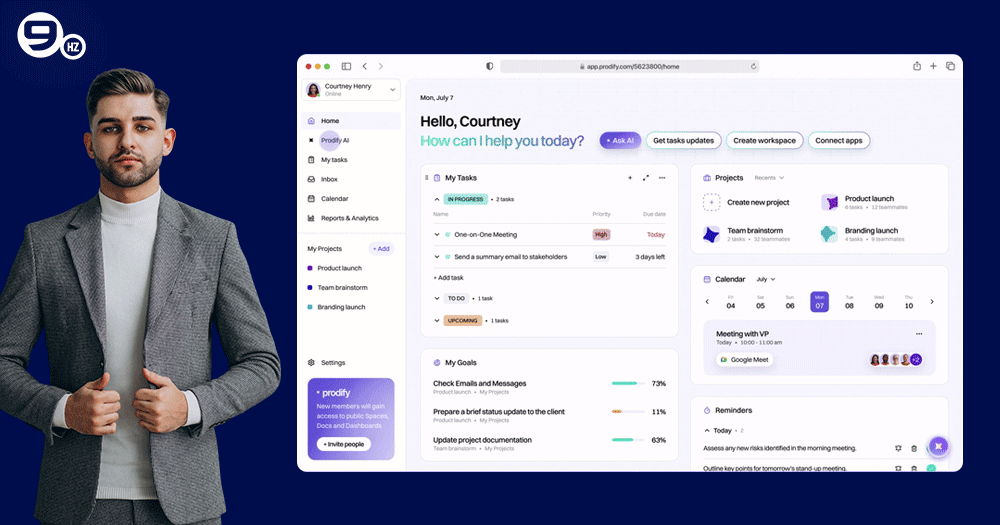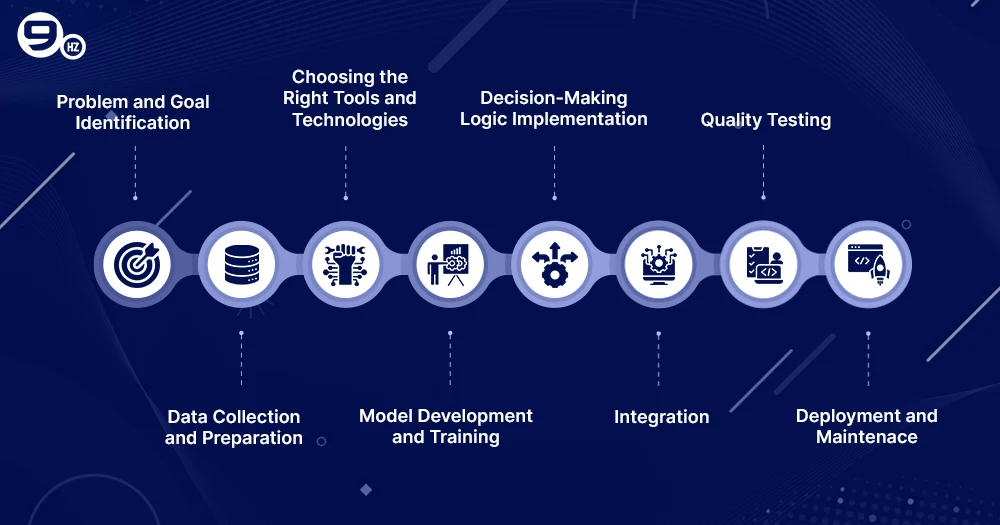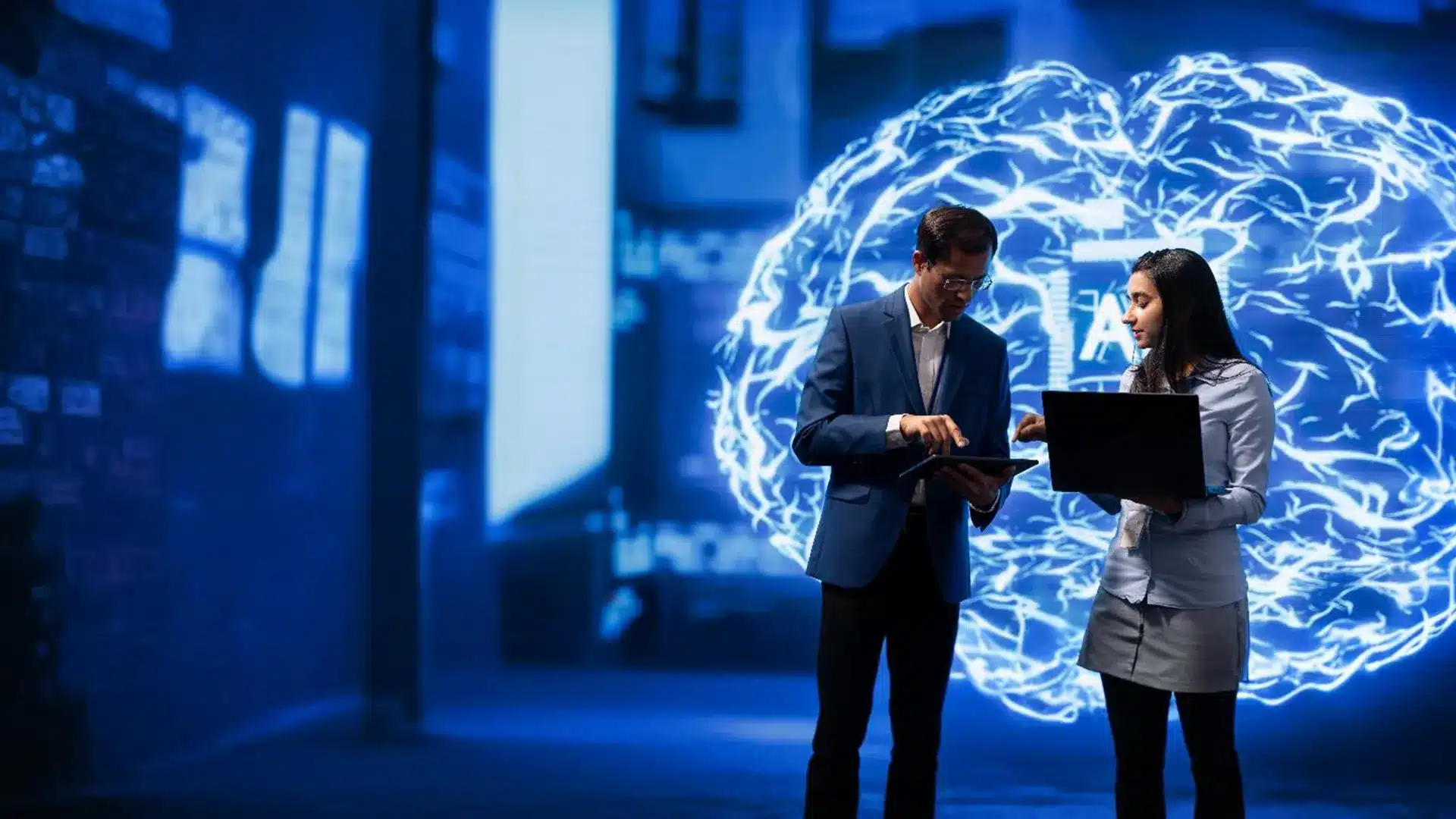The emergence of seamless AI tools like ChatGPT, DeepSeek, and Gemini, has changed the definition of artificial intelligence for businesses. While these generative AI tools are already streamlining and saving thousands of dollars for brands, business owners are now on the hunt to integrate even advanced and more useful AI models in their operations to achieve competitive advantages. According to Statista, the global AI technology market amounts to $244 billion in 2025 which is expected to grow and achieve the valuation of $800 billion by 2030.
In such a scenario, AI agent development is one of the most talked about topics, whether it is a startup or a well-established enterprise. While the AI chatbots are solely focused on providing information, the AI agent is an advanced version that is capable of performing tasks using its intelligence without human interference. However, most business still lacks clarity on “how to build AI agent” which stops them from exploring this technology and automating mundane tasks.
So, in this blog, we will talk all about building an AI agent, the time it takes to build AI agent, the cost of development, required resources, and everything. If you’re looking to work with an AI agent development company, this guide will provide valuable insights. Let’s begin-
What is an AI agent?
AI agents are highly trained and intelligent virtual assistants who can interact with the users, take the information from the datasets, and execute the actions. The AI agents are trained to perform like the personal assistant which can perform a range of tasks like sending emails, reminding about things, generating content, providing ideas, controlling gadgets, and much more. Different types of AI agents are trained with various objectives and datasets. When provided the command, the AI agent fetches the relevant information, interprets the data, makes an informed decision, and thus executes the action that helps to achieve the predefined objective.
The capabilities of AI agents to continuously learn from the interaction with users makes it more advanced than the open-source AI tools. For example, if the CEO of a person has been using the AI for more than a year, the AI agent can easily identify the particular speaking tone, used texts, time of the day, and generic need of that person to execute the task with a personal task. This capability eliminates the need for the users to provide the command in a specific format to receive the right output.
Turn your vision into reality with powerful, customizable AI
How AI agents work?
If you plan to create an agent, it is a good idea to have a slight understanding of the working mechanism of an AI agent so that you can be on the same pace when hiring the AI agent development company.
First of all, AI agents are autonomous agents as they are capable of performing sequential tasks with minimal or the absence of human intervention. In order to build an AI agent, the first task is to make a model that can emulate the human cognitive processes to execute a task. AI agents are highly supported by large language models (LLMs) that focus on breaking down complex tasks into small sprints so that tasks can be easily managed, understood, and executed. The AI agents are trained to learn from their past experiences and interactions with the users to provide better responses in the future.
The concept of “agent orchestration” is deployed to make the AI agent function and able to handle the complex task. To achieve this capability, different specialized agents are integrated into a single system that collaborates, focusing on the different parts of tasks, and giving a single execution. To provide real-time information to the AI agent, different techniques like API integration for internet accessibility or deploying the Retrieval Augmented Generation (RAG) are used. Following are types of specialized AI agents that are mainly used in AI agent development-
1. Observer Agent
This is the first agent in the sequence that interacts with the incoming information by either storing it in the database or adding it to the task queue. For example, we are implementing an AI agent for smart traffic management. So, the observer agent will collect the data by monitoring the cameras, sensors, and GPS data from vehicles. At the same time, it will also record real-time accident patterns, road closures, peak hours, and high-traffic zones.
2. Prioritization Agent
The second interaction happens with the prioritization agent that assesses the series of tasks and ranks them according to their impact on the situation. For example, the AI agent in the traffic management system will evaluate the severity of accident reports and traffic congestion to prioritize the areas that need immediate intervention.
3. Execution Agent
As the name suggests, this is the agent that executes the tasks. For example, it will adjust the traffic signal timings to allow the high-traffic roads to be cleared first. Similarly, it can notify the emergency services and authorities about the accident.
Types of AI Agents
Various types of AI agents offer the variety to the business owners to choose the right one according to their personalized needs and preferences. While some AI agents are better at performing simple or specific tasks, other AI agents are designed to perform more complex or sequential tasks. Different types of AI agents provide a variety for business owners to automate their tasks and bring efficiency without compromising their budget and use cases.
Here are the main types of AI agent along with their key components-
1. Simple Reflex Agents
This is the most basic form of building an AI agent. Simple reflex agents are trained to provide the output of decisions based on their current sensory data without incorporating any learning process or memory update. The complete behavior of the simple reflex agent is controlled by predefined condition-action rules that teach the AI agent how to respond to a particular command.
| Key Components | Use Cases |
|---|---|
| Sensors – Helps to gather information from the environment and act like the input devices. | In manufacturing units shut down machines immediately in case of obstructions. |
| Condition-action rules – The predefined rule that shapes the response pattern to a specific input. | Automated water sprinkler systems to eject water on smoke detection. |
| Actuators – Translating the final decision into digital or physical response. | Email auto responder to send the message by analyzing the keywords. |
2. Model-Based Reflex Agent
If are wondering how to make an AI agent that can detect the anomalies in the security system, or identify the pattern to execute the action, you must choose the model-based reflex agent. This is the more advanced form of AI agent that is designed to operate in the observation environment. It keeps an image of the ideal environment and instantly reports to the user whenever there is any disturbance in the pattern.
| Key Components | Use Cases |
|---|---|
| State Tracker – Helps to maintain the information about the current environment state. | Used in home security systems to identify the difference between normal routine and potential threats. |
| World model – Tracks how the environment evolves and determines the agent’s action. | Helps manufacturing businesses to find anomalies in their operational process. |
| Reasoning component – Uses the world model to provide the action according to the condition action rule. | Identify traffic patterns to recognize the potential issues. |
3. Goal Based Agent
As the name suggests, this AI agent is designed to achieve a specific objective while considering the future results of an action. It can plan the sequence of tasks to achieve the predefined objective as it uses search and planning algorithms.
| Key Components | Use Cases |
|---|---|
| Goal State – Clear description of the ultimate objective. | Used to plan optimal paths that can easily locate items in the warehouse. |
| Planning Mechanism – The model’s ability to identify task sequence to achieve goal. | Setting the automated temperature in heating and cooling systems. |
| State Evaluation – Architecture to assess the potential future results. | Establishing a reordering schedule to maintain optimal stock levels. |
| Action Selection – Mechanism to choose the action to achieve desired results. | Prioritize the operational sequence to get tasks completed before the deadline. |
| World Model – To understand how actions will be changing the environment. |
4. Learning Agents
This is the type of AI agent that can enhance its performance by learning from experience and interaction with the user. Various learning mechanisms are integrated into these AI agents that help to optimize the performance over time and thus they can discover the best ways of achieving the goals. So, the learning agents don’t solely rely on the pre-programmed knowledge and datasets to perform certain actions.
| Key Components | Use Cases |
|---|---|
| Performance Element – The component to select the ideal external action. | Identifying the best settings that enhance manufacturing processes. |
| Critic – Evaluate the outcomes to provide feedback on the agent’s performance. | Identify patterns that lead to optimal resource consumption. |
| Learning Element – Uses the feedback to identify techniques that can help enhance the performance. | Learns to identify objects accurately. |
| Problem Generator – Recommends the exploratory actions that provide the new experience, leading to a better future decision. | Improve response according to past interactions. |
5. Utility-Based Agents
The utility-based mechanism helps AI agent development that can analyze the potential outcomes of different actions and choose the one that serves the most utility. This model assigns the value to different outcomes and thus it can handle the tradeoffs by competing the different goals.
| Key Components | Use Cases |
|---|---|
| Utility Function – The mathematical function that represents the desirability of different states. | Establish the overall balance between machine usage, production goals, and energy consumption. |
| State Evaluation – The method to assess current as well as future state. | Ensure optimization between maintenance costs, and comfort. |
| Decision Mechanism – The process that helps to choose the right action for maximum utility. | Balance the resource constraints with deadlines and task priorities. |
| Environmental Model – Identify the effect of different actions on resulting utilities. |
6. Hierarchical Agents
This AI agent is structured in a tiered system where the tasks of lower-level agents are monitored and managed by the higher-level agents. This principle focuses on breaking down complex tasks into different manageable sub-tasks for better decision-making and organized control.
| Key Components | Use Cases |
|---|---|
| Task Decomposition – Used to break down complex tasks into smaller units. | Facilitate coordination in the overall production process. |
| Command Hierarchy – Defines the flow between different agent levels. | Manage different systems like HVAC and lighting. |
| Coordination Mechanism – Establishes the collaboration between different agent levels. | Breaks the complex tasks for robots into simple actions and movements. |
| Goal Delegation – Distributes the smaller goals to lower-level agents. |
7. Multi-Agent System
This is an advanced version of AI agents where multiple autonomous agents interact with each other, and work collaboratively to achieve the collective goals. While this agent is capable of performing comparatively complex tasks, it keeps the working mechanism seamless by establishing streamlined interactions between multiple basic AI agents through simple rules and protocols. The following are three types of multi-agent systems-
- Cooperative System– The mechanism that enables basic AI agents to share resources and information to achieve mutual goals.
- Competitive System– Agents bid in a simple auction system to claim the resources.
- Mixed System– Ensures seamless competitive and cooperative behavior.
| Key Components | Use Cases |
|---|---|
| Communication Protocols – Elaborates the exchange of information among agents. | Ensuring the collaboration between different robots in the warehouse. |
| Interaction Rules – Establishes the rules for agents to interact with each other. | Facilitating the coordination between multiple machines for seamless operations. |
| Resource Management – The right mechanism for handling shared resources. | Managing the storage space and processing times. |
| Coordination Mechanism – The system to effectively organize activities and prevent the chances of conflicts. |
Expert Guidance. Zero Guesswork. 100% Execution
7 Benefits of AI Agents
The implementation of smart AI agents has provided remarkable results to businesses by streamlining operations, enhancing decision-making, saving costs, and increasing overall productivity. Talking about the ROI, it has been reported that businesses that implement the right AI agent in their workflow can cover up the cost within the first 2-4 years and leverage the increased revenue ahead.
1. Enhanced Operational Efficiency
This is the foremost benefit that the business can expect when planning to build an AI software. Whether it is automating mundane tasks or establishing the optimized usage of resources, AI agents take care of everything. For example, when an AI agent is used in the smart home system to control the fans, appliances, switches, and lights, it can provide convenience to the residents while also managing the overall energy consumption. Similarly, deploying the AI agent in the customer support team ensures high-quality response around the clock.
2. Boost Productivity
AI agents are never the replacement of human workers but a catalyst to increase their overall productivity. According to the data, businesses using AI agent have witnessed a 40% increase in their workforce productivity. Smart technology automates the repetitive tasks of businesses so that the employees and human workforce can be utilized for productive and creative tasks. At the same time, AI agents also help in reducing human errors which increases the overall accuracy of tasks and makes the services more reliable for the target audience.
3. Better Customer Experience
AI agents make it very easy for the brand to better understand its customers, deliver a personalized shopping experience, and increase customer loyalty. First of all, the AI chatbot helps provide 24*7 customer support in multiple languages. So, customers don’t have to wait in the queues to get their queries solved. At the same time, AI agents are capable of finding the perfect solution to customer queries based on their trained dataset. Similarly, these smart agents also help to connect the customers to the right and concerned department for the resolution of their query.
4. Cost Saving
AI agents can perform tasks with higher speed and accuracy as compared to a normal human worker. So, it balances the reliance of businesses on human resources and helps control the cost. At the same time, businesses don’t have to hire different customer support teams to connect to users in different time zones, the AI agent can do this effortlessly. The decision-making is significantly enhanced with the implementation of an AI agent which eliminates the feedback implementation costs.
5. Scalable and Flexible
AI agents are highly versatile to various business needs where you can design a smart solution according to your real-time business needs and make the required updates if the workload increases in the future. Choosing the right features that you need also ensures that you pay only for what you need and thus you are not wasting financial resources. Unlike human resources, you don’t have to worry about the efficiency of an updated AI agent.
6. Data-Driven Decision
As stated earlier, AI agents play in vital role in driving data-driven decisions in the organization. Whether it is analyzing the market trends and demand to predict the right stock level or assessing the user preferences on social media to produce the best content idea, AI agent performs exceptionally well in data assessment areas. The new technology also makes it easier for the brand to run strategic and personalized marketing campaigns to generate maximum ROI.
7. Competitive Advantages
There are very few businesses that are leveraging AI agents in their operational process and thus one can gain significant competitive advantages in their industry by developing an AI agent at the right time. From quick testing of new ideas, and smarter problem solving to faster R&D cycles and better team collaboration, AI agents deliver numerous advantages and competitive edge to the businesses.
7 Applications of AI Agents
Discussion about the real-life applications of AI agents can help to better understand the use cases and significance of this burgeoning technology. Let’s explore some of the best applications that help you in the right AI agent development for your business.
1. eCommerce AI Agents
AI agents are highly used in eCommerce businesses where they help to automate the number of tasks to provide a better customer experience.
- Automatically place the order after scheduling or setting the reminders.
- Provide real-time shipping updates by tracking the product.
- Helps users to search for a product by using the image.
- Sending timely reminders to customers about their filled or abandoned carts.
- Personalized product recommendations to customers to increase the chances of a successful purchase.
2. Sales & Marketing AI Agent
The data analysis capabilities of AI agents make them the best technology to shape their marketing and sales strategies.
- Helps in building the lead list by studying responses from the clients.
- Prioritizes the qualifying leads and reduces time wasted on low-quality leads.
- Send timely and personalized messages to existing and potential clients.
- Study competitor’s activity to suggest the strategies.
- Personalizing the marketing campaign according to customer demographics.
3. Customer Support AI Agent
This is one of the most used applications of AI agents where brands rely on the technology to provide customer support to their stakeholders.
- Helps in general tasks like password updates, refund processing, etc.
- Facilitate product recommendations according to purchase history.
- Assists in handling and reporting technical issues.
- Provides round-the-clock customer support in multiple languages.
- Builds a bridge between concerned departments and customers.
4. Dynamic Pricing System
The AI agents help to change the prices of products and services over time according to real-time market conditions.
- Enable ride-hailing services to set their prices according to weather conditions, time, availability, and demand.
- Studies competitor’s pricing to suggest the best price range to attract customers.
- Helps food delivery businesses to implement late-night or extreme weather charges.
5. AI Recommendation System
AI agent is used by many content platforms to suggest better content to their users and increase the engagement rate.
- Netflix uses a content recommendation system to suggest movies and series to their users.
- Spotify relies on the AI Recommendation Engine application of AI agents to suggest relevant songs to users.
- OTT platforms analyze the user watch history to adapt to the changing preferences of users over time.
6. Autonomous Vehicles
AI agent is a core part that makes self-driving cars functional and safe to use.
- Utility-based AI agent helps in decision-making while driving the cars.
- Goal-based AI agent is used for navigation assistance.
- Model-based reflex agents are useful to facilitate real-time responses.
- Learning agents help automated cars to learn and enhance performance over time.
7. Employees AI agent
AI agents are also designed to establish better collaboration among the internal and external stakeholders of the organization.
- Used by decision-makers to connect to their teams.
- Highly used by employees to set reminders, send emails, and assist in data analysis.
- Implemented by HR managers to track employee performance and shape strategies to increase productivity.
How to build an AI agent from scratch: Development Process
The technology partner you are choosing to create an AI agent must deploy a well-managed and result-driven methodology to achieve the outcomes. While some of the strategies might different from one developer to another, the overall process and stages are almost the same. So, let’s answer the question “how to build an AI agent from scratch” so that you can make the right decision for your project.
1. Problem and Goal Identification
The foremost development stage is always dedicated to identifying the current challenges faced by businesses which are expected to be solved by building an AI agent. At the same time, it is also very important to set mutual goals so that you can track the key performance indicators and measure the overall efficiency at the end.
2. Data Collection and Preparation
Once all the stakeholders of the project have the same goal in mind, the next step is dedicated to gathering and processing the data that will be used to train the AI model. It is one of the most important parts of the process as the gathered data will determine the efficiency of the AI chatbot. Data gathering includes collecting datasets for AI model training from different data sources like databases, web scraping, API, etc.
Data processing is also carried out at this stage which focuses on handling the missing values, correcting the inconsistencies, and removing the duplicate data. Data processing helps to prepare the data to use it to train the AI model.
3. Choosing the Right Tools and Technologies
The very next step talks about choosing the right tools and technologies that help to build an AI agent. It is important to choose the right technology stack as it acts like the architecture of your AI agent and makes it scalable and flexible. Here are some of the core tools and technologies to create an AI agent.
| Category | Technology | Best For |
|---|---|---|
| Programming Languages | Python | AI chatbots, recommendation systems, NLP, deep learning |
| JavaScript | Web-based AI apps, browser-based AI tools | |
| Java | Enterprise AI, fraud detection, automation | |
| C++ | High-performance AI (gaming, robotics, self-driving cars) | |
| NLP Tools | NLTK | Tokenization, speech tagging, text classification |
| spaCy | Real-time NLP applications | |
| Transformers (Hugging Face) | Pre-trained AI models (GPT, BERT, T5) | |
| Machine Learning Development Tools | TensorFlow | Deep learning, complex model training |
| PyTorch | AI research, advanced ML applications | |
| Scikit-learn | Traditional ML (classification, regression, clustering) | |
| Computer Vision Tools | OpenCV | Image processing, facial recognition, object detection |
| TensorFlow/Keras for Vision | Deep learning-based image classification | |
| Speech Recognition Tools | CMU Sphinx | Offline speech-to-text |
| DeepSpeech (Mozilla) | Deep learning-powered speech recognition | |
| Google Speech-to-Text API | Cloud-based real-time voice recognition | |
| Web-based AI Tools | Rasa | Open-source chatbot framework with NLP |
| Dialogflow (Google) | No-code AI chatbot builder | |
| TensorFlow.js | Running AI models in web browsers |
4. Model Development and Training
As the title suggests, this is the stage where the development team chooses the right model for AI agent development. The different AI models are unsupervised learning models, supervised learning models, and reinforcement learning models. Moving ahead, the AI model is trained by splitting the data into training and testing sets. It is ensured that the model is seamlessly fetching the data and providing the desired outputs.
5. Decision-Making Logic Implementation
This is the stage where the algorithms are implemented in the AI model to drive decision-making capabilities. For example, a use-based system is used for simple reflex agents while Bayesian networks or Markov Decision processes are used for complex agents.
6. Integration
Once the AI agent provides the desired results according to the command provided by the users, it is integrated into the existing technical architecture to be accessed by the end-user. It includes API development so that AI agents can work with the other software components. Development tools like IDEs and CI/CD pipelines are used for the integration.
7. Quality Testing
Before completely deploying the AI agent in the final technological architecture, the AI agent undergoes various testing processes. It includes unit testing to ensure that every component is working well, integration testing to ensure that the AI agent is working seamlessly with other software, and user testing to collect feedback from stakeholders and make required improvements.
8. Deployment and Maintenace
Once the AI agent has qualified all the quality tests, it is prepared to deploy on the respective platform. The right deployment platform like AWS, Google Cloud, Azure, or on-premises servers is used for the deployment. After the deployment of the AI agent, the targeted users can leverage the benefits of the AI agent by performing the desired tasks.
The maintenance of software is an ever-going process that ensures that deployed AI agents are performing according to expectations and achieving the pre-defined goals in the external environment. Moreover, the maintenance also helps to provide updates according to new market trends.
Cost of AI Agent Development
If you are wondering how much does it cost to build an AI agent, you must understand the fact that the exact AI agent development cost is influenced by multiple factors. While an AI agent with limited capabilities can be developed for a few thousand dollars, an advanced AI agent can cost a hundred thousand dollars.
Generally, it costs anywhere between $50,000 to $500,000 to build a fully functional AI agent. However, the cost can differ significantly according to particular business needs and preferences. Here are the core factors that determine the cost of building AI agents.
| Complexity and Features | It requires the advanced features and functionalities to perform the critical tasks. So, the higher complexity of the AI model directly leads to the increased AI agent development cost. |
| Customization | Choosing a customized AI agent development requires more time and resources and thus it costs way more than pre-built software solutions. |
| Data Requirements | The type of data required to train the AI model to make it functional also influences the development cost. For example, the quality and quantity of data are directly proportional to AI agent development cost. |
| Integration Requirements | The integration process of AI agents to the existing system and technological infrastructure is also associated with different fees. |
| Development Team | You might need the support of highly skilled developers and designers to build a custom and high-performing AI agent. So, an experienced and large development team contributes toward the overall development cost. |
| Testing and Maintenance | If you are hiring an AI agent development company to provide the maintenance and technical support to the final product, it will add dollars to the cost of building an AI agent. |
| Platform and Implementation Costs | Deployment of AI agents requires cloud services and enterprise platforms. It comes with training fees, licensing charges, and integration work charges. |
Why Choose The NineHertz for AI Agent Development?
The quality and capabilities of the final depend hugely on the AI development company that you choose for your project. The NineHertz carries an experience of 15+ years in the industry and has helped 100+ businesses to digitize their operational process. We have a team of 250+ specialists who master their respective areas of field to collaboratively build high-performing AI agents.
Our team offers free consultation sessions to businesses looking to build an AI agent. During the consultation, we assess the real-time challenges and business goals to suggest the best type of AI agent. At the same time, we also provide the idea about required resources, costs, timeline, and other factors that help the clients to make better decisions. We conduct frequent workshops during the project that facilitate seamless collaboration with stakeholders and steer a better development process.
The NineHertz offers ample maintenance and support after the deployment of AI agents where we assess the performance of AI agents to make the required improvements. Moreover, we also provide frequent updates to the final product to add new features and make it synchronize with changing market trends.
Conclusion
We can conclude that AI agents have been transforming businesses of all types to leverage accuracy, automation, and increased productivity. There are different types of AI agents requiring different types of datasets to perform the desired tasks. The development process is the set of different phases that take the development forward by ideating, designing, data collecting, training, testing, and deploying the AI agent. The efficiency of the development process is supported by a strong technological architecture that makes the AI agent scalable and adaptable to business requirements.
If you are also planning to create an AI agent for your operational process, contact The NineHertz and sign up for our free consultation session.
Frequently Asked Qestions for Building AI Agents
How Much Does It Cost to Build an AI Agent?
Generally it costs anywhere between $50,000 to $500,000 to build an AI agent. However, the cost can differ significantly based on different factors. Here are the core components that affect AI agent development costs-
- Complexity and Features
- Customization
- Data Requirements
- Integration Requirements
- Development Team
- Testing and Maintenance
- Platform and Implementation Costs
How do AI agents differ from AI chatbots?
AI agents are much more advanced software as compared to AI chatbots. The AI agents are trained to simulate human capabilities by performing different types of tasks and making decisions on their own according to the trained data. On the other hand, chatbots are merely AI bots with chat interfaces that can only answer questions and produce content.
Great Together!






![How to Create an App like Careem? [Cost in 2025]](https://theninehertz.com/wp-content/uploads/2024/09/how-to-create-an-app-like-careem.webp)






